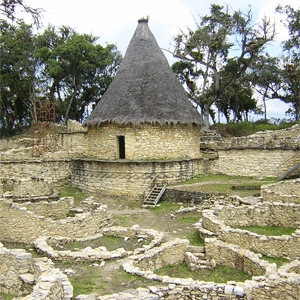
Kuélap (Cuélap)



The Chachapoyas culture ancestral walled citadel of Kuélap is located on a mountaintop limestone ridge at elevation 3000 meters (9842 feet) on the west bank of the Utcubamba River, district of Tingo, Luya Province, Amazons, in northern Peru. Covering an area of 15 hectares (37 acres), the site has over 550 circular structures, and may have had 300,000 inhabitants. The inhabited area, sits atop an 18 meter high (60 feet) walled table, which is entered through three narrow stair cuts, one of which narrows to allow only one person to enter at a time. Considered the largest stone ruin in the Americas, Kuélap's outer wall, a shell filled with rubble core, is comprised of massive limestone blocks nearly 10-times the volume of the blocks used in Egypt's Giza Great Pyramid. According to archaeologists, the majority of structures were built between 900 CE and 1100 CE., but it is a controversy whether Kuélap was built as a defense against the surrounding tribes of the Huari culture. The citadel was abandoned in 1570 CE during the Spanish conquest.
Elevation is c. 3028 meters (9933 feet) above sea level.
Materials: The outer citadel wall is a limestone block wall casing containing a rubble interior; the residential and ceremonial architecture is composed of limestone walls with thatch roofs.
Data for CG model:
1. Bradley, Robert, 2005. The Archiecture of Kuelap, Submitted in partial fulfillment of the Requirements for the degree of Doctor of Philosophy in the Graduate School of Arts and Sciences, Columbia University.
2. Bradley, Robert, 2015; Reconsidering the Notion of Fortaleza Kuelap, Journal of Field Archaeology, February 10, 2015.





